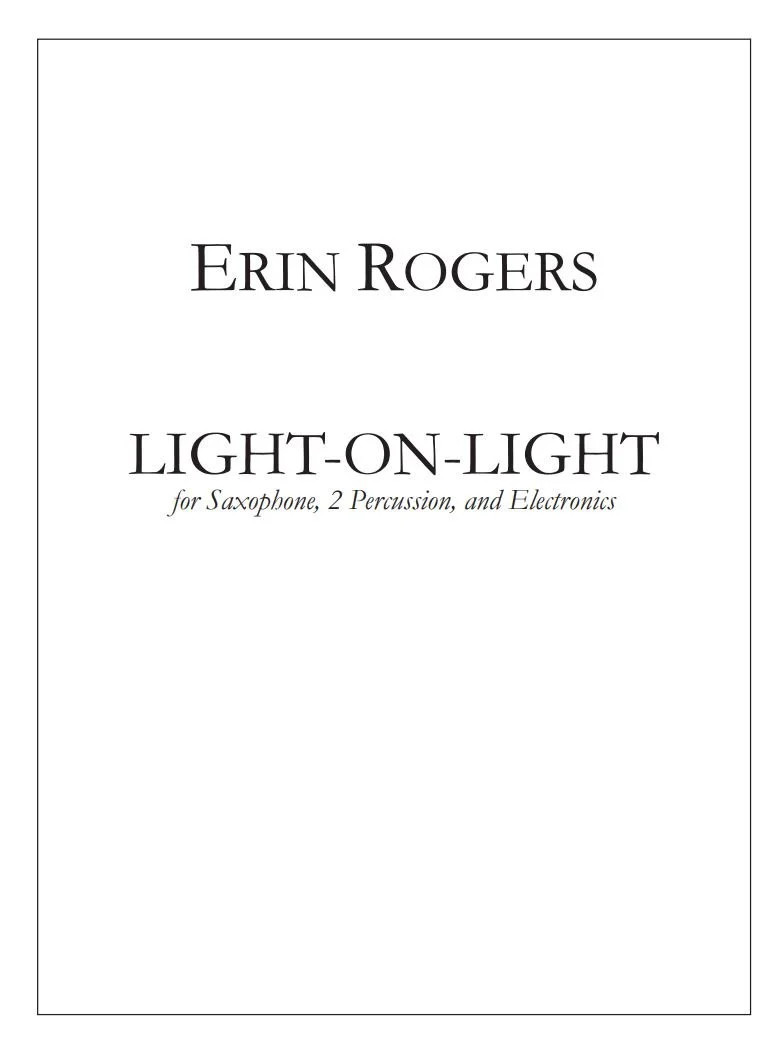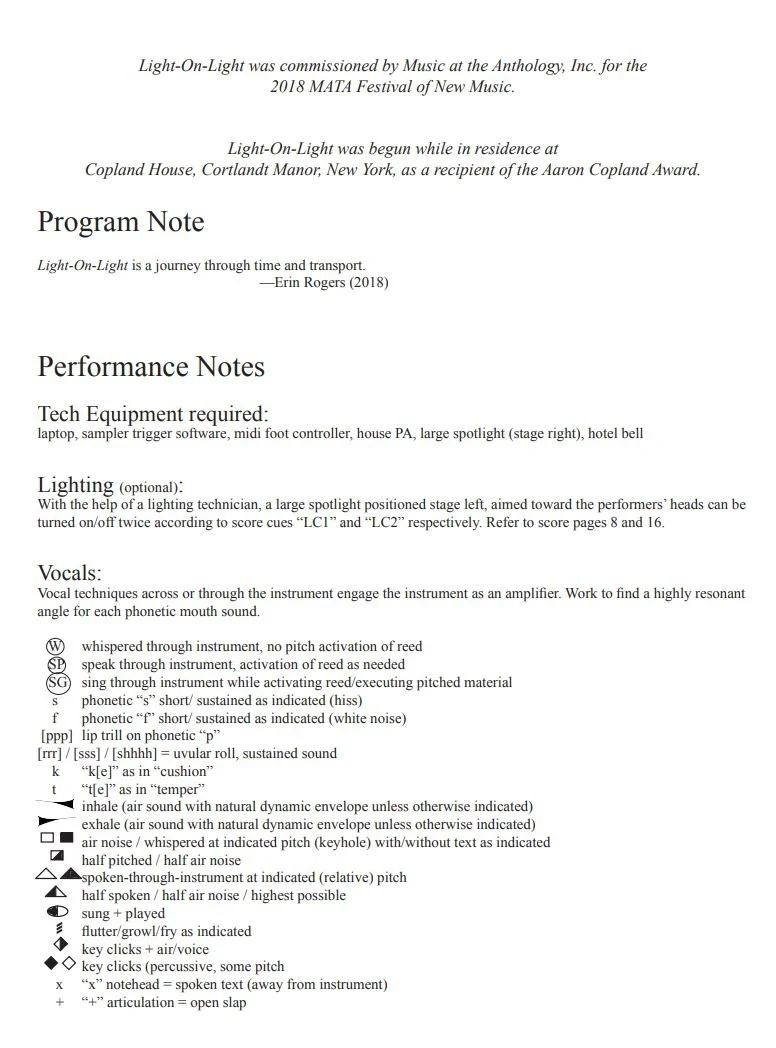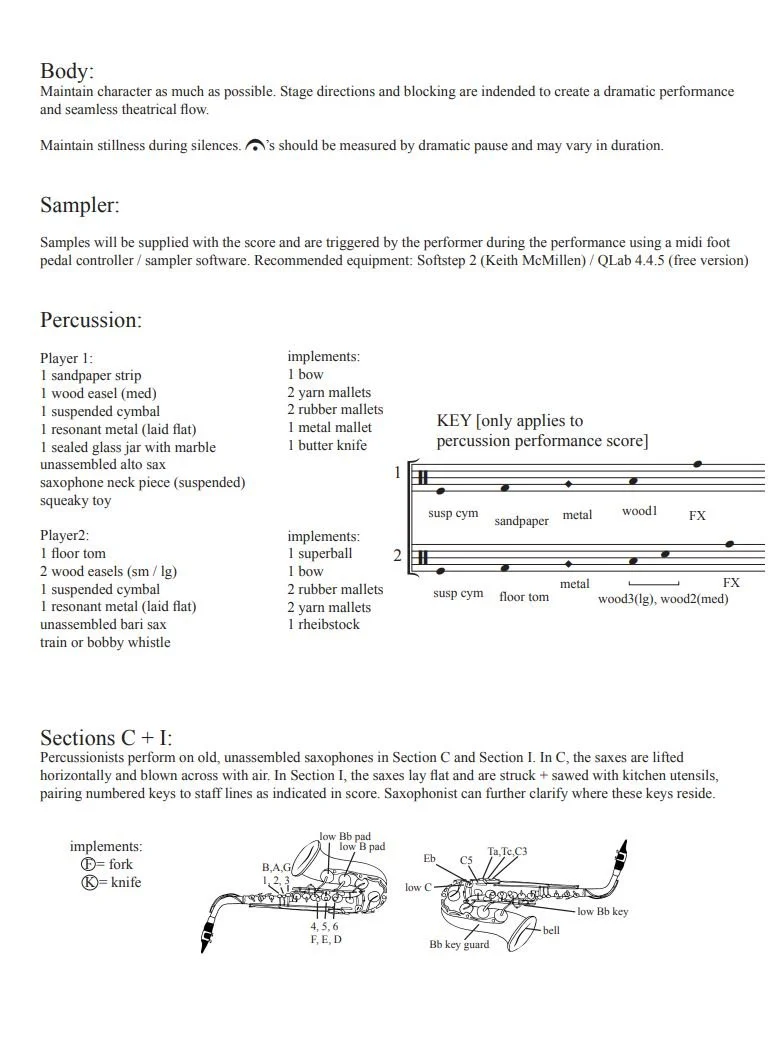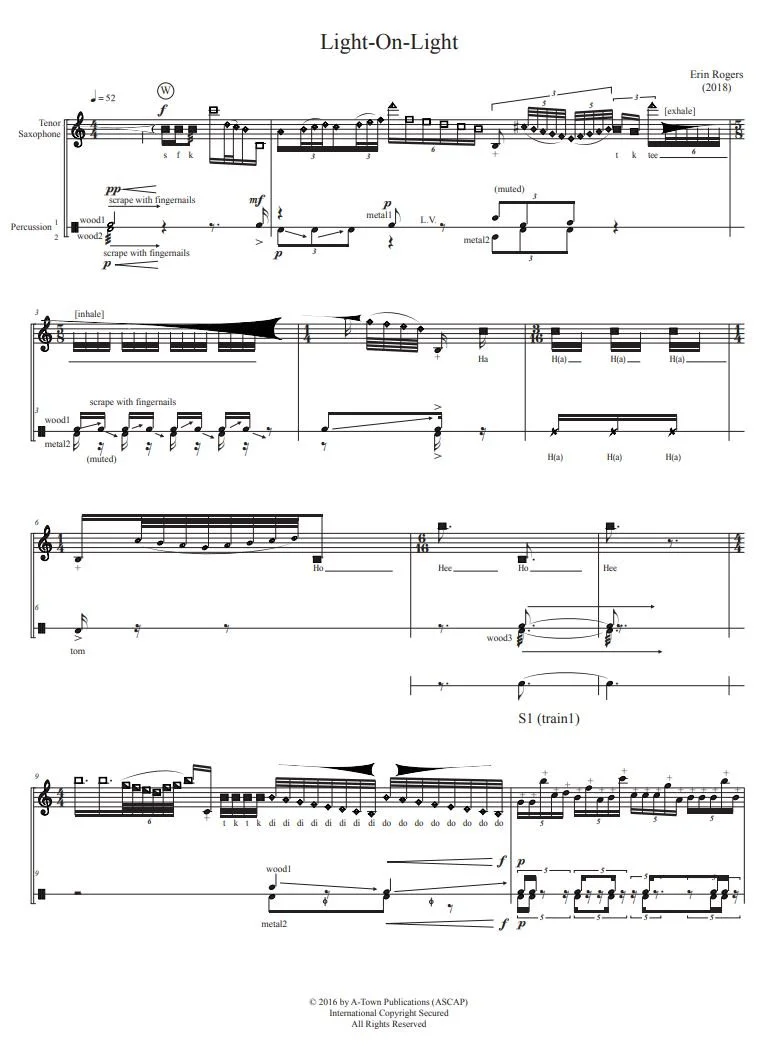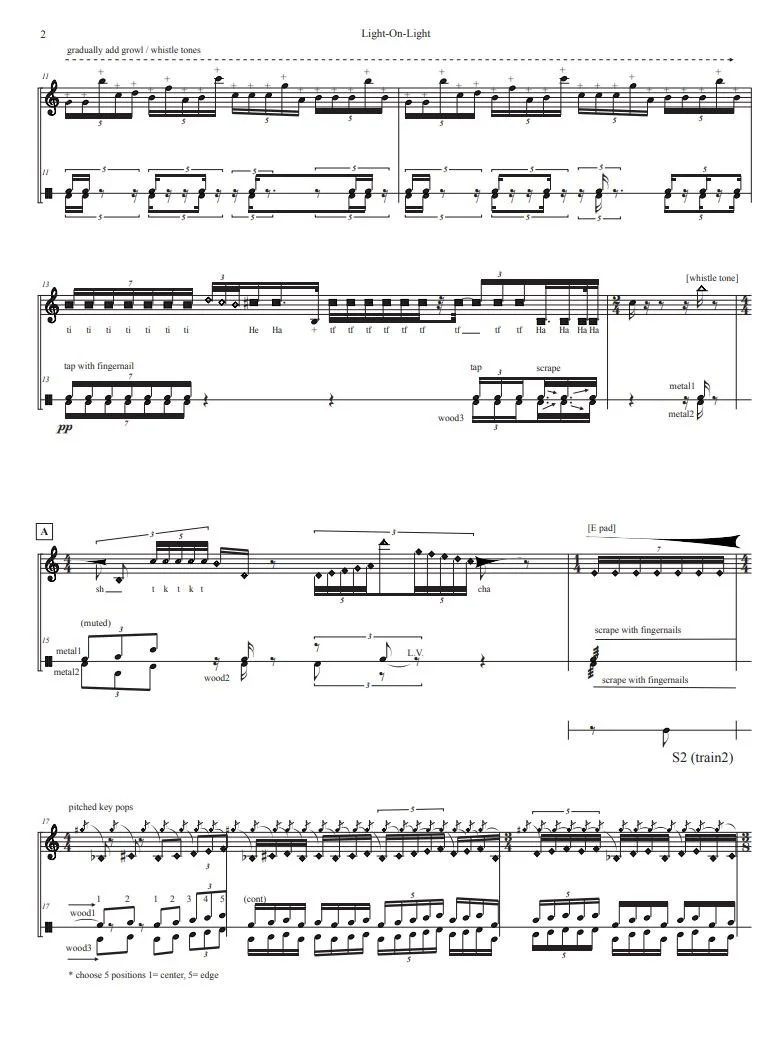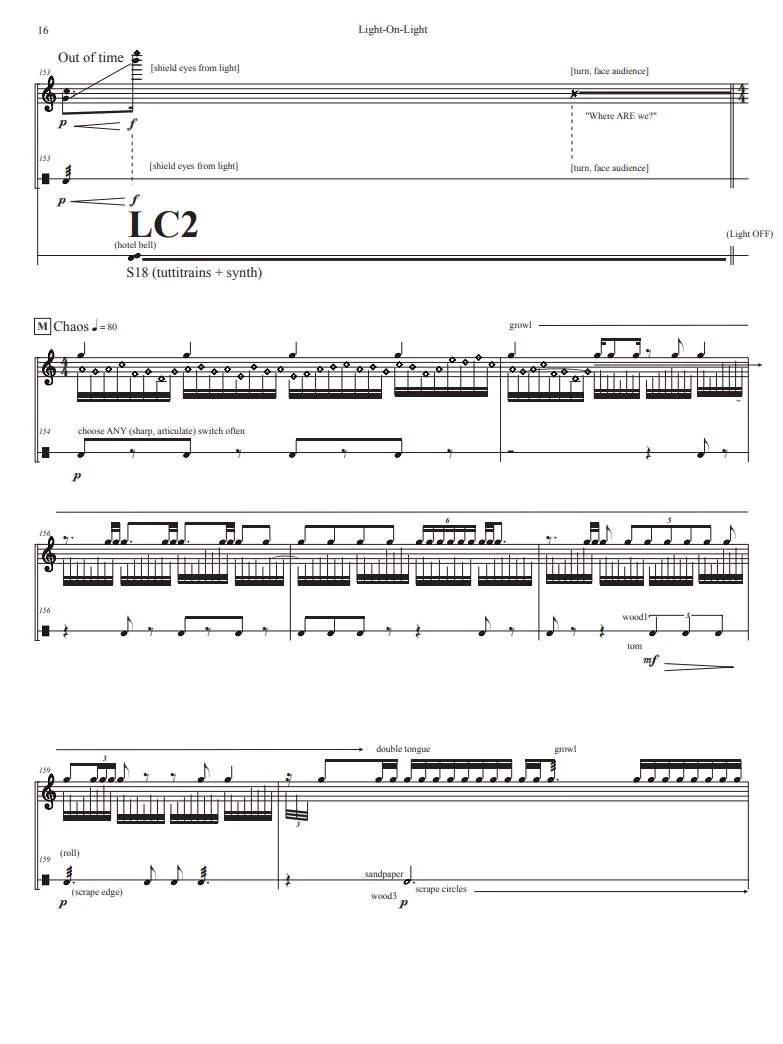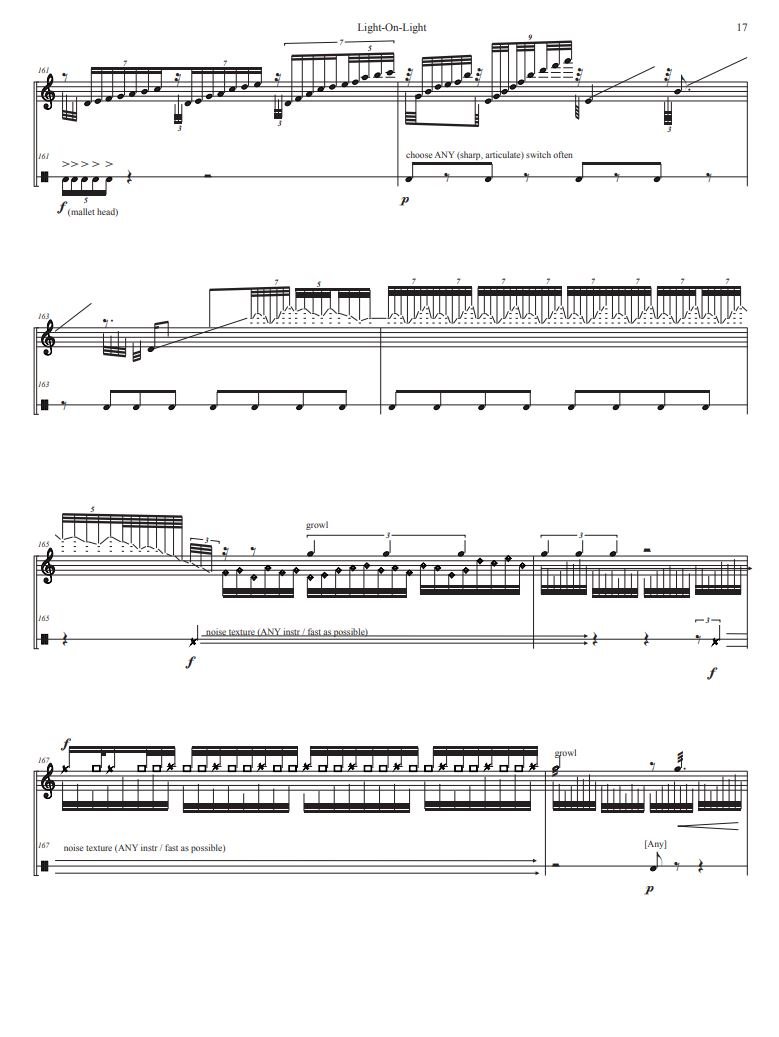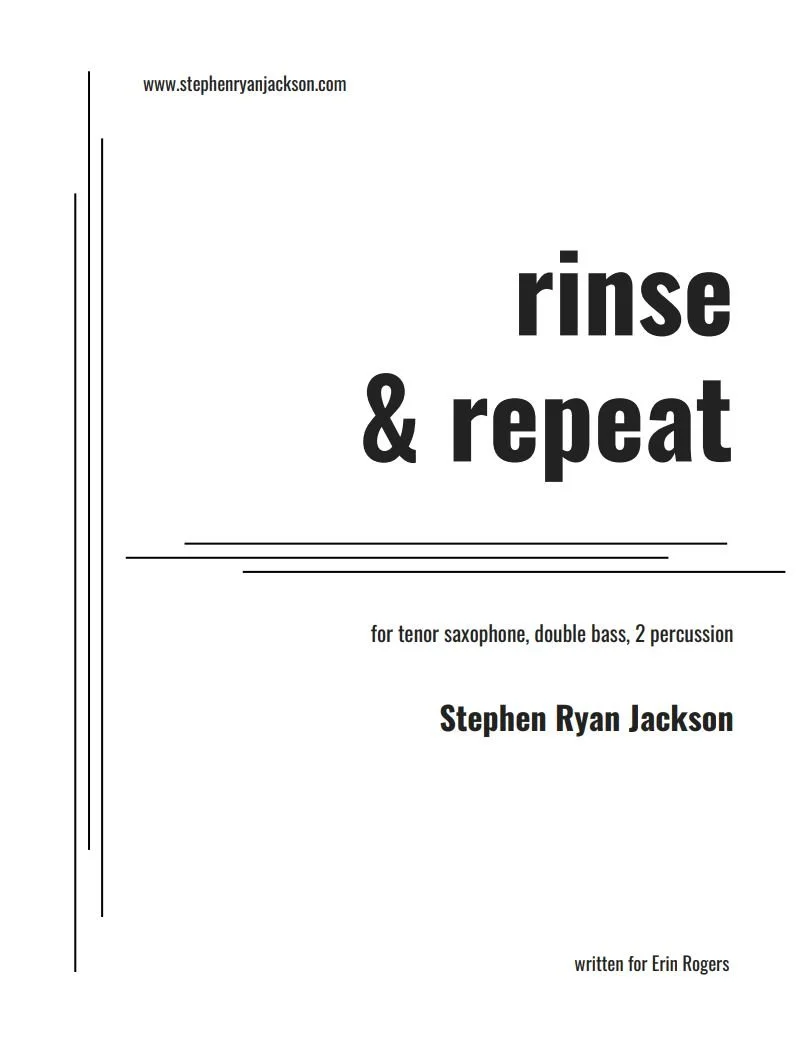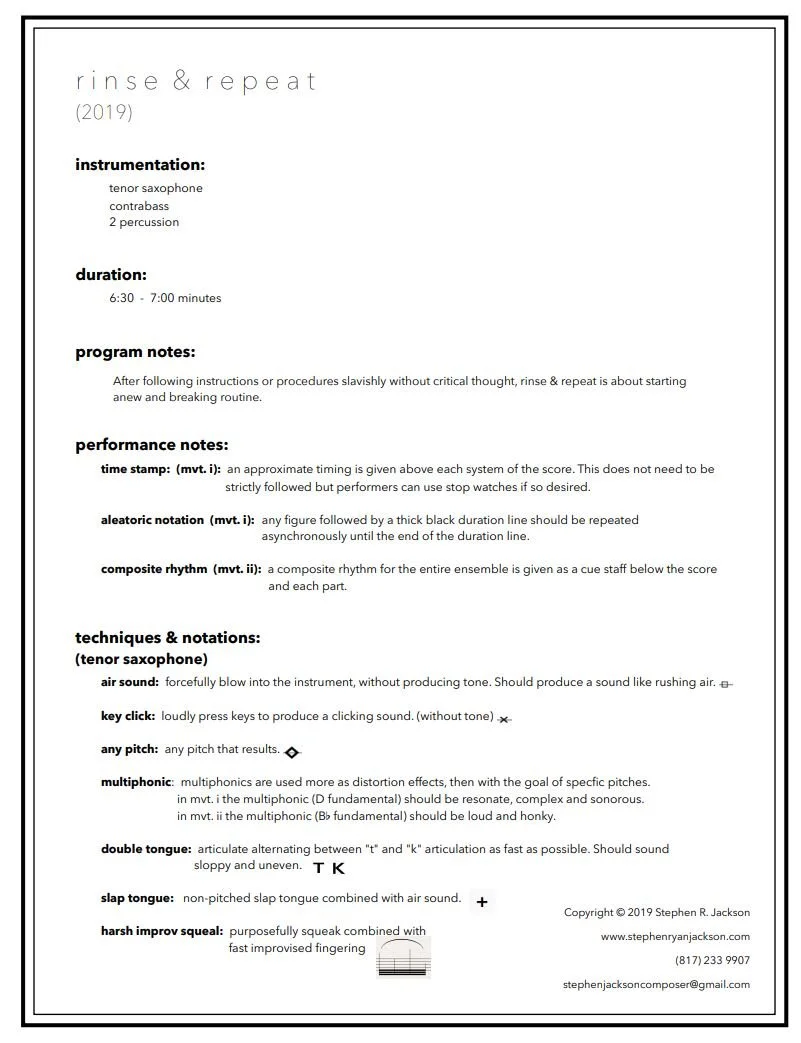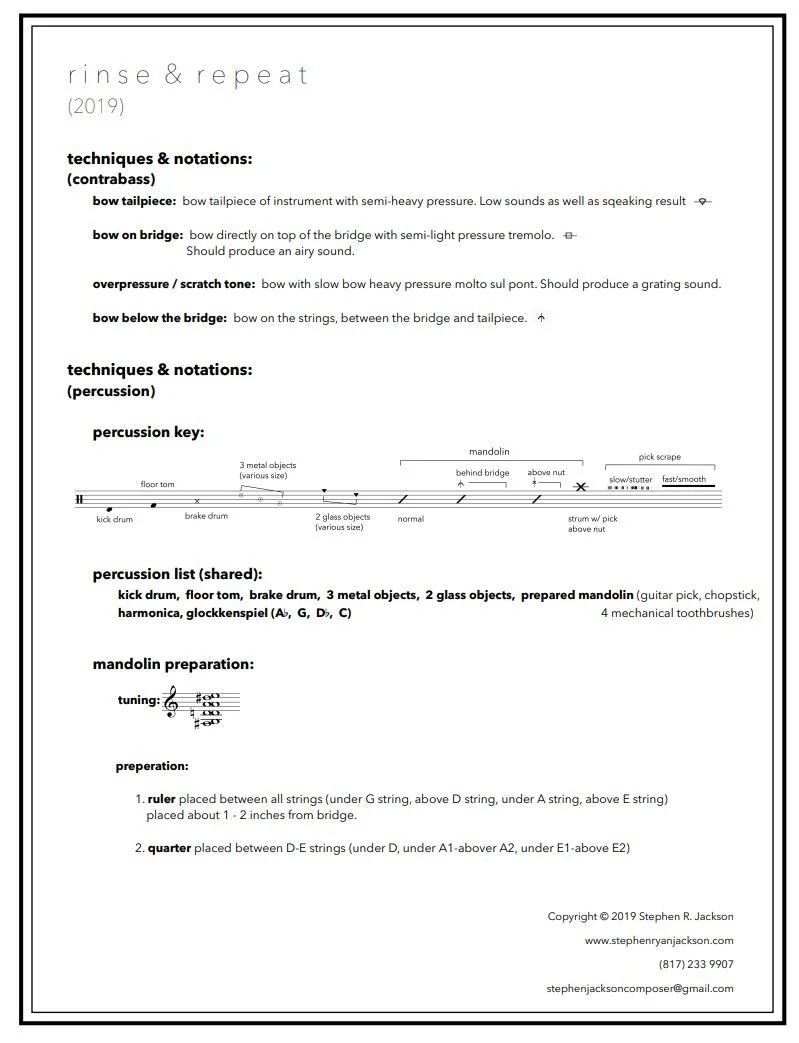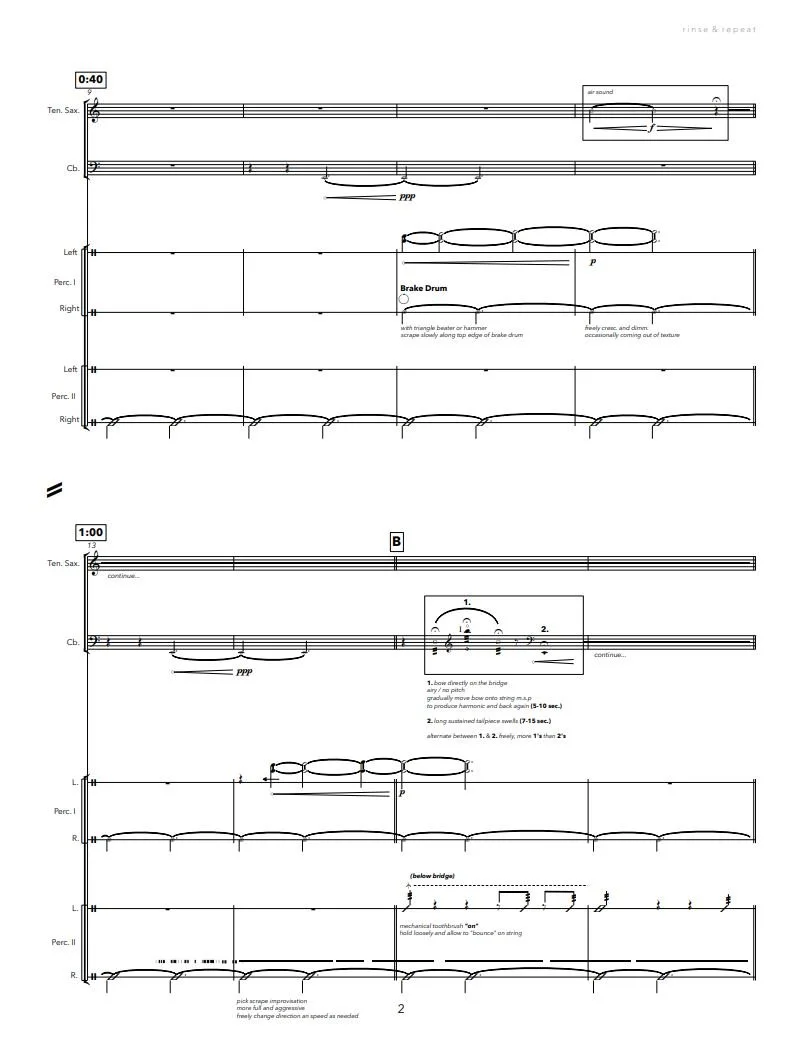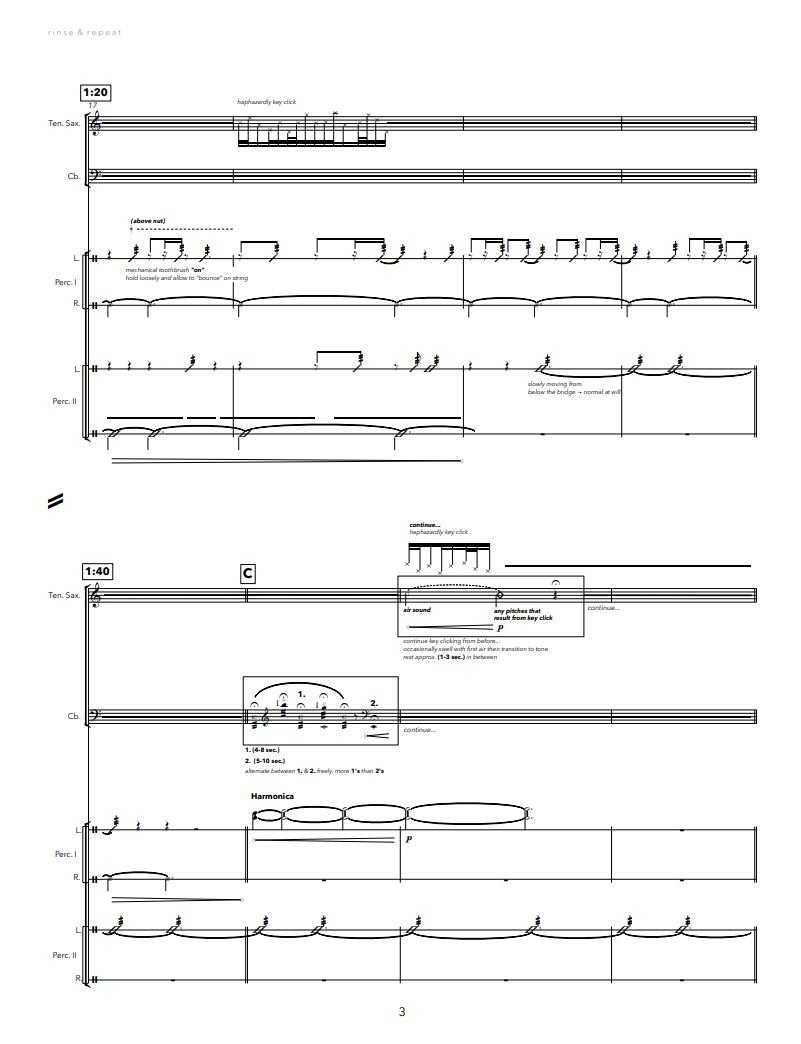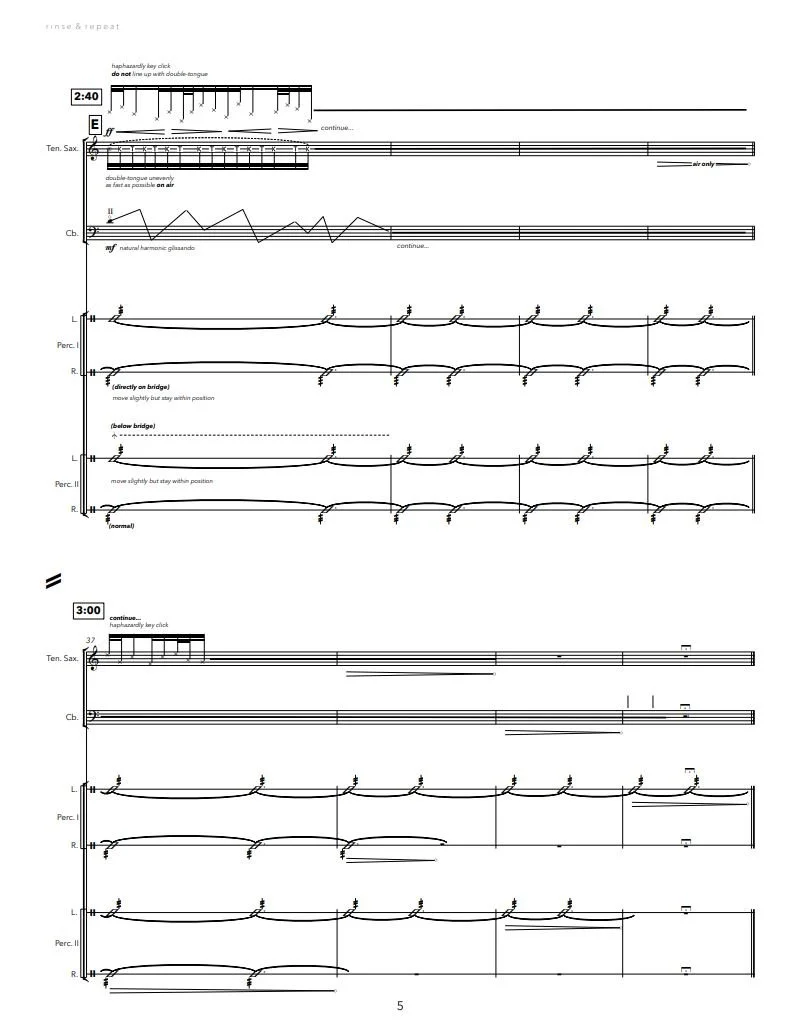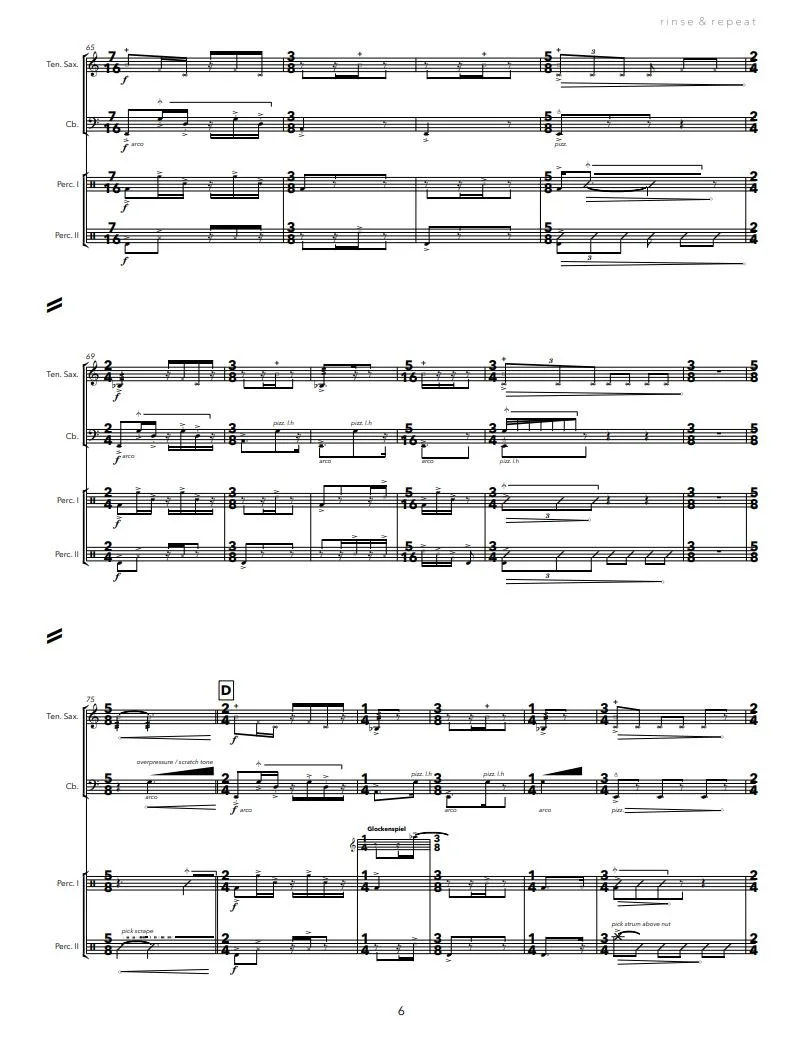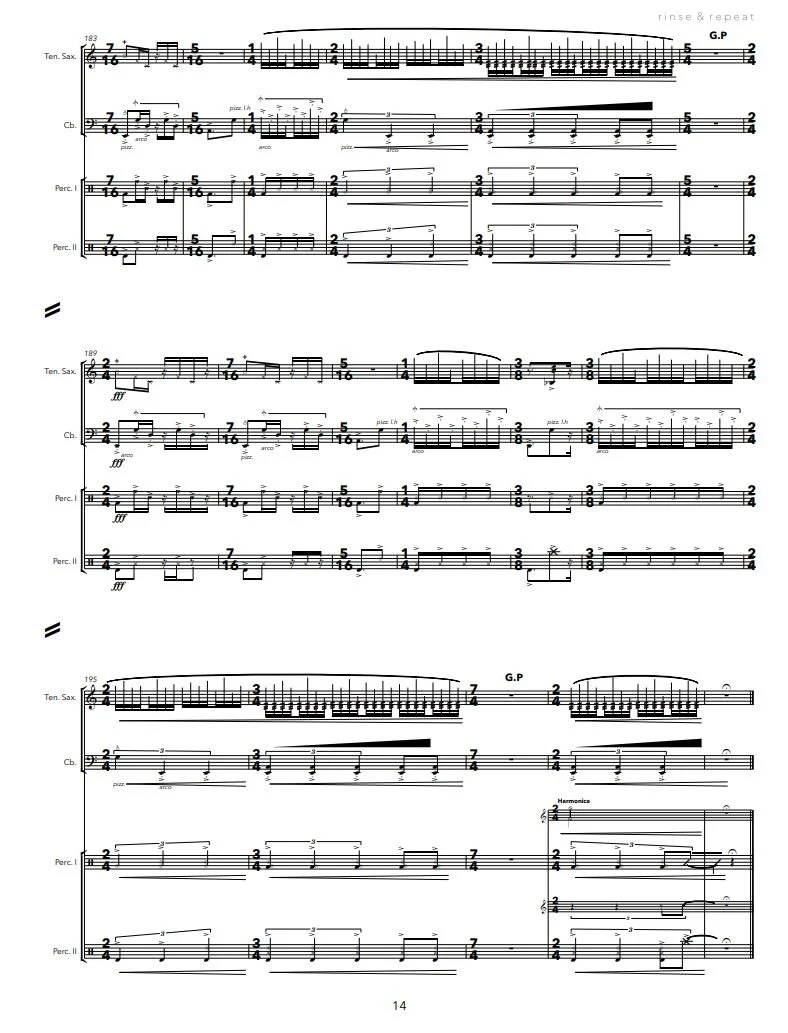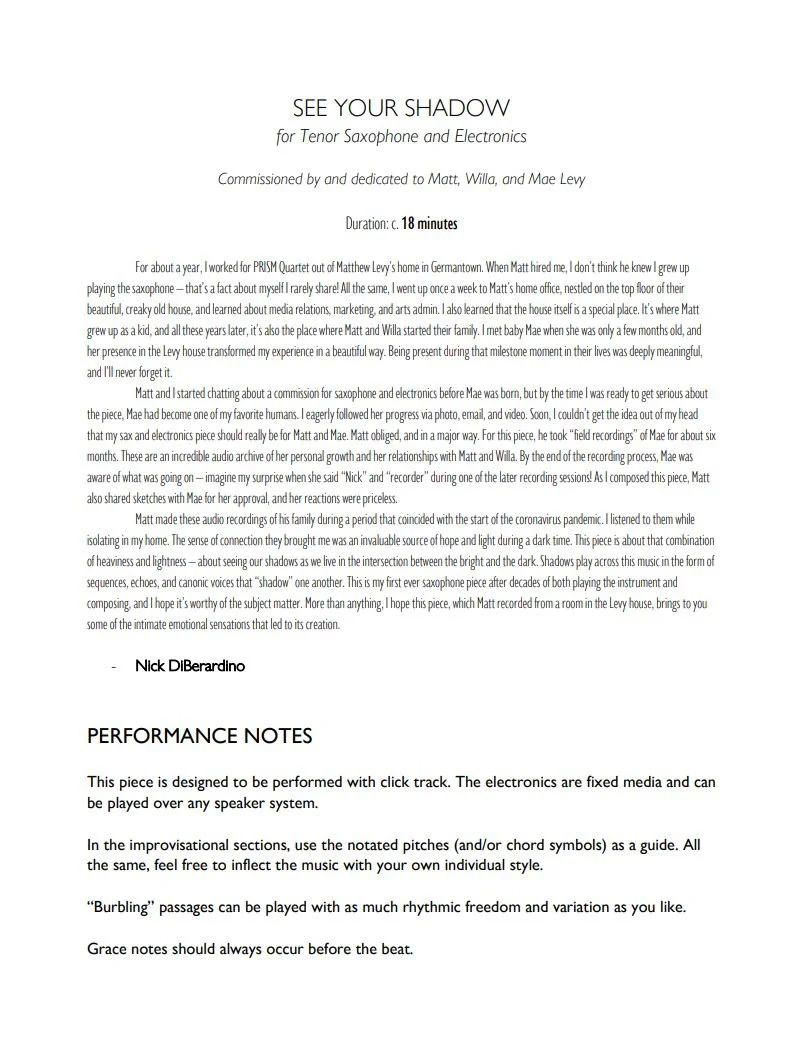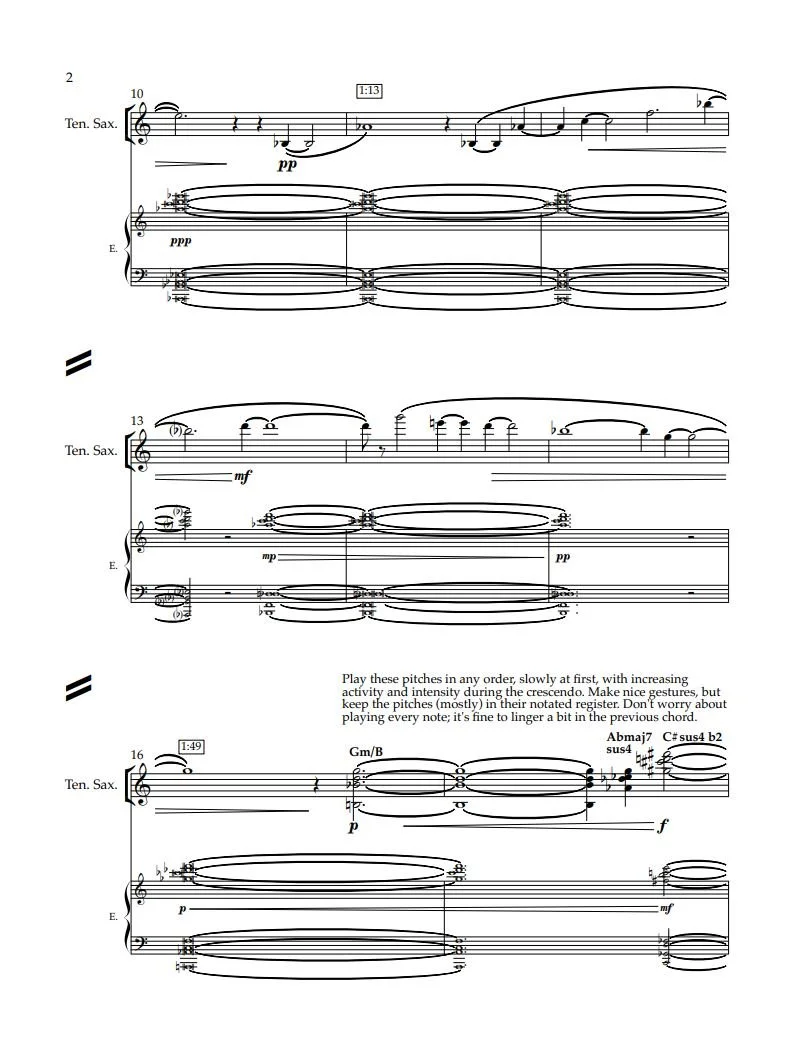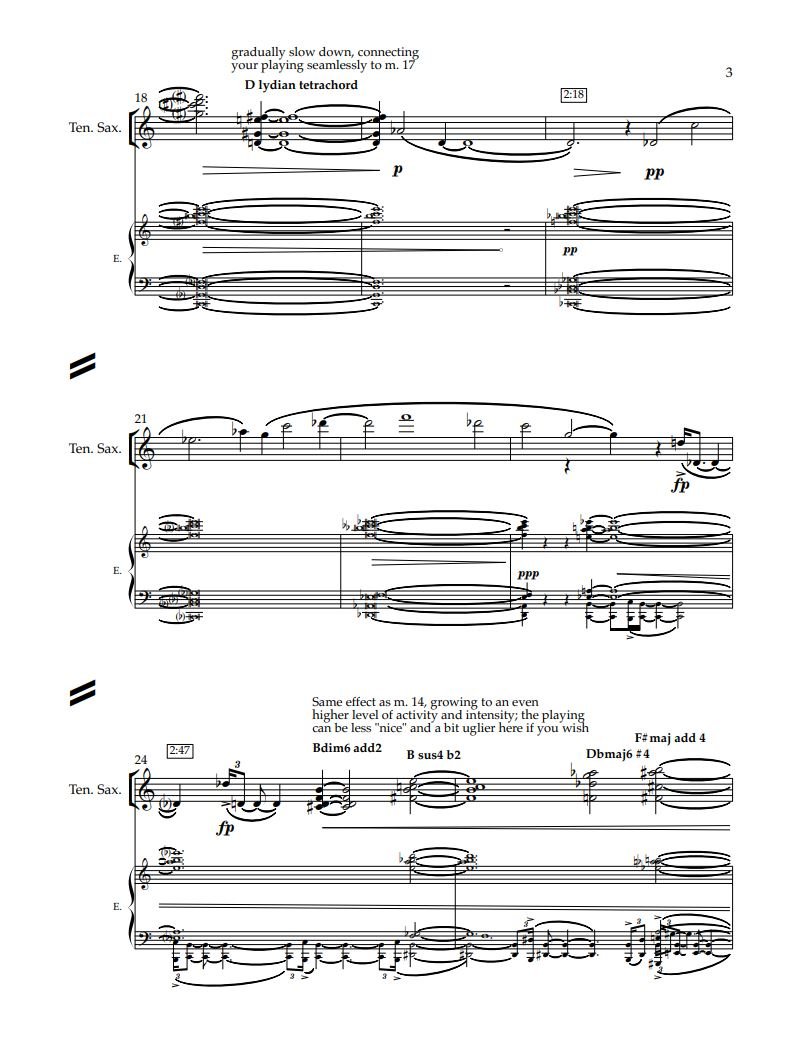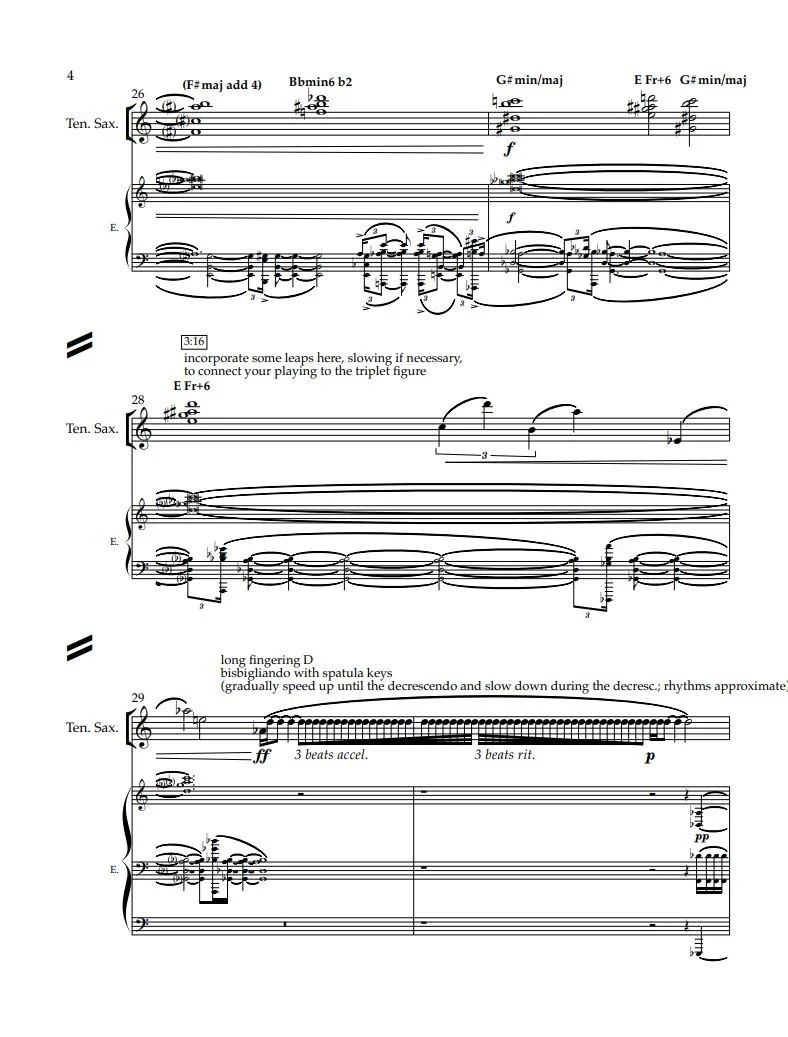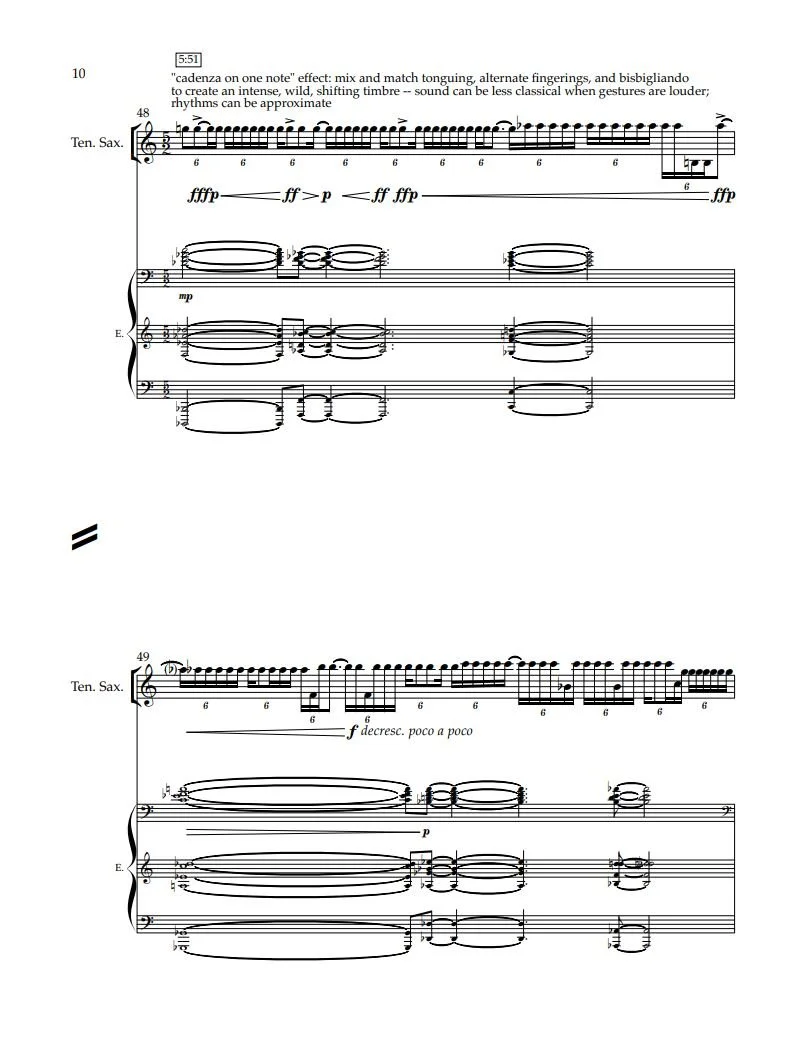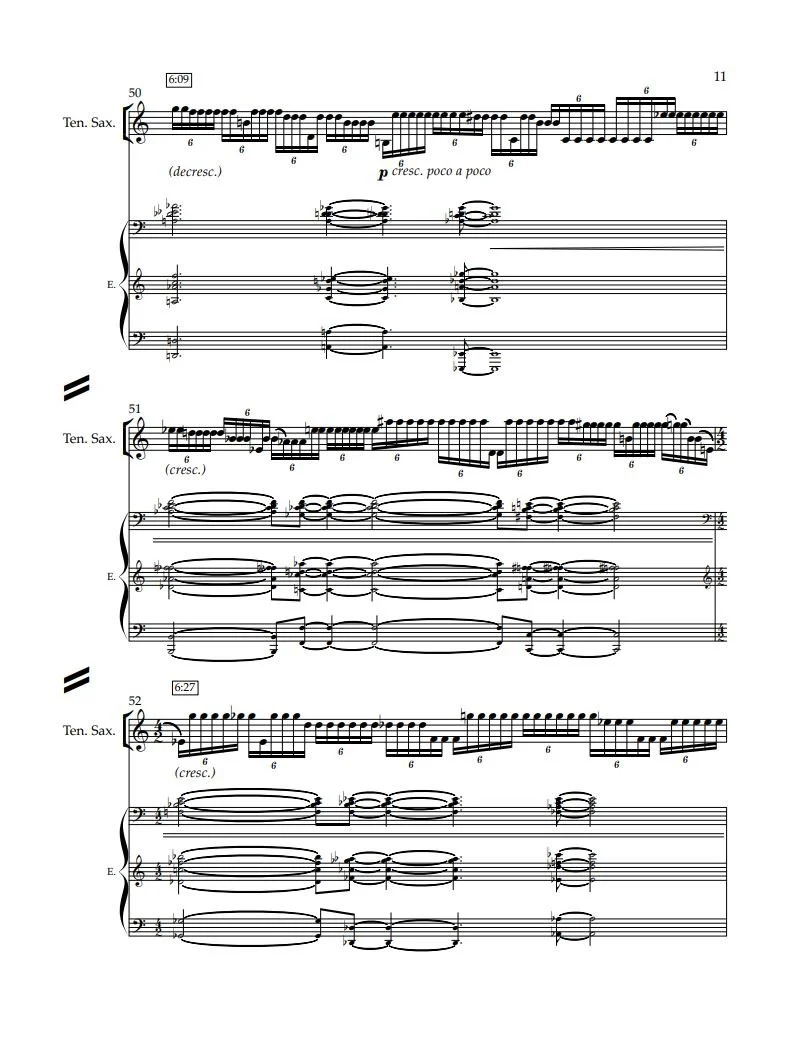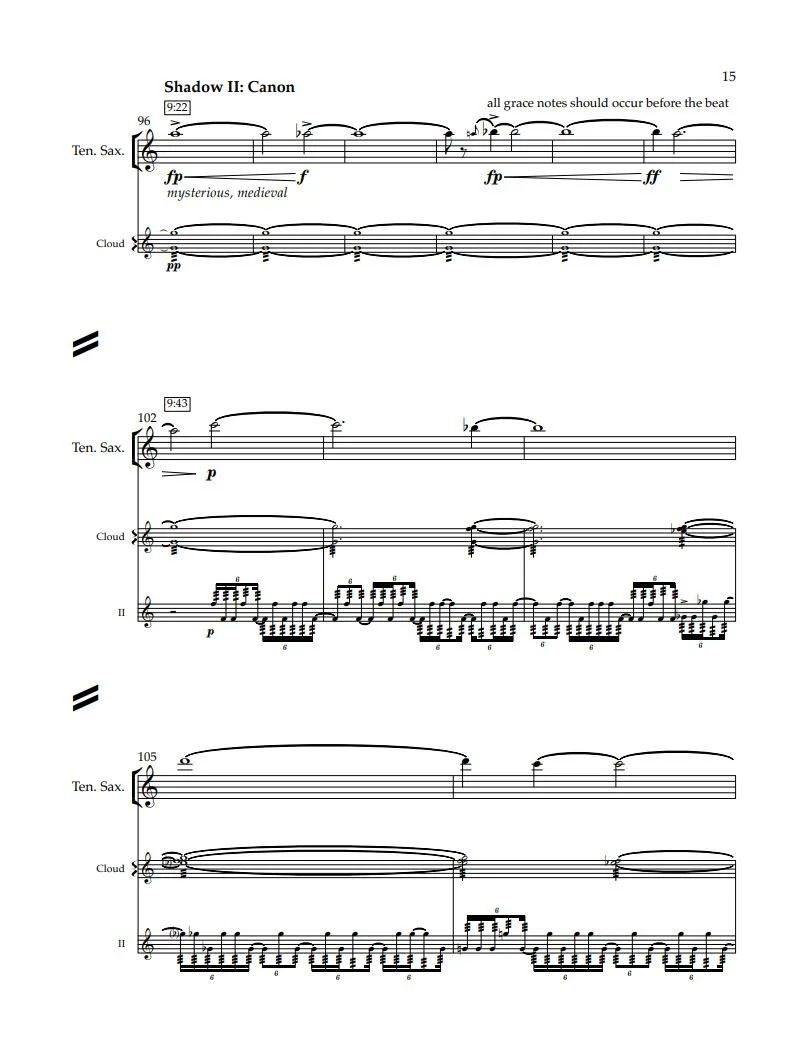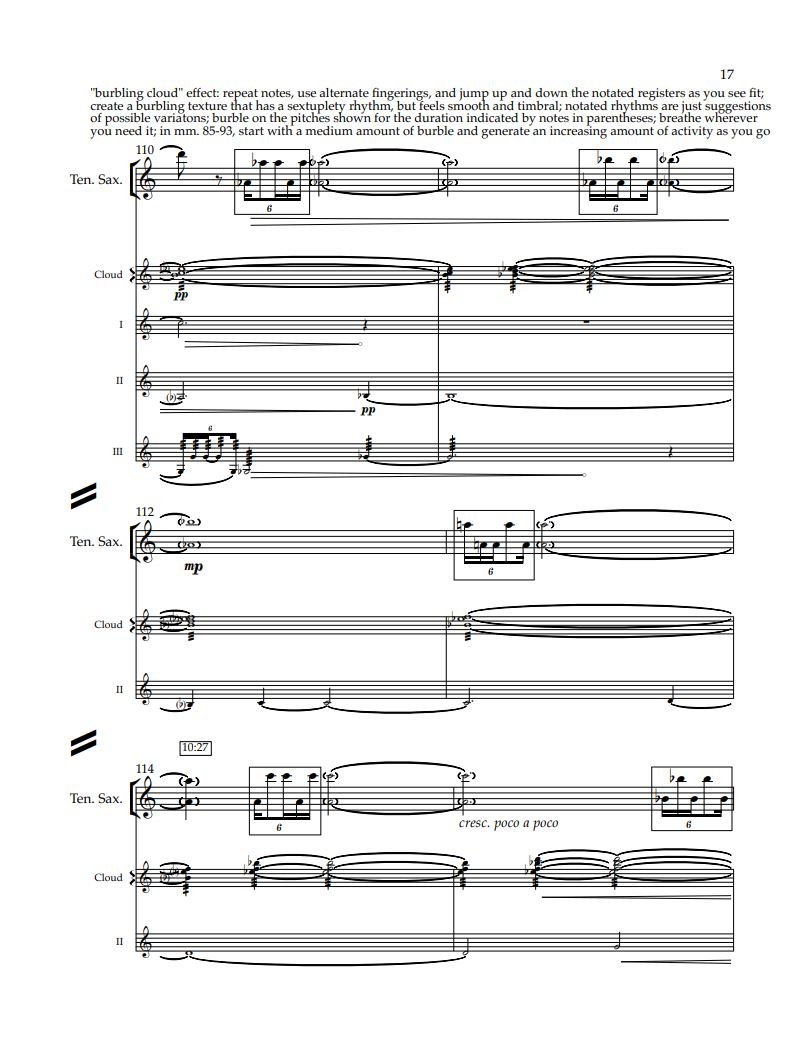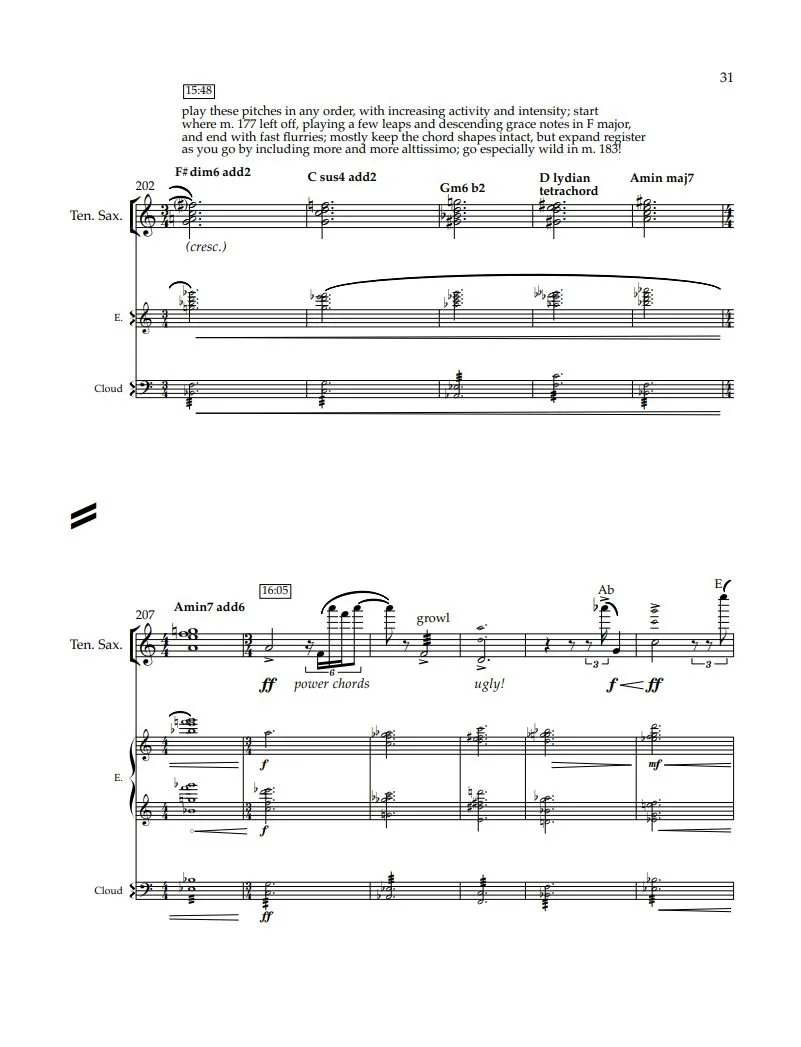
Tenor Saxophone
Air Sounds
2 types: one through the instrument and the other through the mouthpiece. Players can change the timbre of their air sounds using a “sssss” voicing. Pitch can also be manipulated. Altering pitch is typically notated with fluid lines on the staff indicating general shape of pitch and direction.
Articulations for air sounds can also be changed using syllabic pronunciations. In the example below, notation and phonetic sounds are indicated in the tenor saxophone part. Air speed and the natural dynamic gestures are indicated in the notation.
Dynamic Ranges:
On the mouthpiece: n - mf
Through the instrument: n - mf
Light-On-Light mm. 1-2, Erin Rogers (2018). For a more complete score, scroll to the “score” section at the bottom of this page.
Altissimo
Altissimo is an extended higher range on the instrument. This range will vary from player to player, but professionals should have about an octave of extended range. It is difficult to play soft dynamics given the piercing nature of the high tessitura. It can also be difficult to play incredibly fast passages. Players will usually have 3 to 4 different sets of altissimo fingerings that all connect with one another to be able to play faster passages. Consult with your player about what is possible.
Dynamic Ranges: n - ff*
*Altissimo dynamics vary greatly depending on the fingerings used for the passage. Players have alternate sets of fingerings that speak different form one another. Some sets are used for lengthier notes because of their dynamic possibilities and intonation while others are used for quick runs.
Alla Tromba
This technique is played by having the player remove the mouthpiece and buzzing their lips into the neck of the saxophone similar to a trumpet or trombone. The lower notes on the saxophone resonate much better than the higher ones, but high notes still sound fantastic. Preparation time is needed to take the mouthpiece on and off, about 3 to 5 seconds. If the player needs to put the mouthpiece back on too quickly, intonation can be influenced. Most players can perform an octave, 2 octaves if they specialize in this technique. Depending on the saxophone (bari/tenor/alto/soprano) they are using, the range will change.
Composers and performers should know that the pitches will be higher when performing this technique unless the missing piece of saxophone “tubing” is replaced. This can be done with prepared saxophone techniques such as plastic tubing or brass mouthpieces.
Special notation is not needed for this technique as it is typically played in “sections” of a piece. Writing the words “Alla Tromba” above the particular section suffices.
Dynamic Ranges: mp - f
Double and Triple Tonguing
Fast articulation that allows players to play quick passages and tongue all the notes. This can become tiring if done for too long, but typically there are no limits. Double and triple tonguing does not need to be notated as it is typically a technical choice a player will make based on what is required of them in the music.
Players have two options when it comes to their triple tonguing choice. “Ta” (T) and “Ka” (K) are the phonetics used, T being for the traditional articulation and K allowing the tongue to attack the roof of the mouth and briefly interrupting the air stream for the added articulation. The combinations of T and K are TKTTKT or TKTKTK.
Dynamic Range: n - ff
Flutter Tongue
Flutter tongue allows for a timbral change in the sound. Players have two ways of producing the flutter tongue sound; either by rolling their “R”s or by gurgling. Flutter tongue sounds very similar to growling, so many players will swap out one for the other if they feel it is needed.
In higher registers, especially altissimo, the flutter can be less pronounced as more throat control is required to play these pitches.
Dynamic Range: n - ff
Growling/Singing While Playing
Players can hum into the instrument to produce a scratchier sound. On saxophone, it is more traditionally used in other genres such as rock, pop, and jazz. Players can also change the pitch of their hum to sing and play notes at the same time. Note that if the sung pitch falls at an interval of a 5th or octave, the voicing/feeling for the player changes drastically. This can also produce multiphonics as the saxophone and voice pitches collide. If a player can sing exactly a 5th above the lowest note on the instrument, an extended range can be reached with notes called Tartini Tones. These tones are very “bassy” sounding. They are rarely used in compositions, but interesting nevertheless.
Dynamic Range:
Growling: mp - ff
Singing while playing: mp*
*Growling and singing while playing are one in the same technique so-to-speak. Singing while playing could be called the extra extended technique to growling.
The sounds produced by growling can be played at a fairly wide range of dynamics. Singing, however, changes the purpose of the sound trying to be produced. When singing is called for in a part, it becomes distinct compositionally as it is typically meant to be a second melodic/harmonic line present in the sound. Given the prominent nature of the saxophone sound required the start humming in the first place, this new second melodic line made by the voice does not project very well in most cases. It can be effective in solo saxophone music, but is not found in many contexts outside of this.
Key Clicks
Typically very soft in dynamics. Can be effective in solo playing but less so in ensembles, especially if other instruments are playing pitched notes. Key clicks and air sounds are a standard combination as the keys can change the pitch/timbre of the air sounds.
Dynamic Range: n - mf*
*Key click projection depends on how many keys are clicked and which keys. Because the saxophone is a tube like many other instruments, the more tone holes closed, the lower the pitch and the more it can project. When closing tone holes specially hard, feint pitches can be heard especially in the low register.
Leg Mute
Players can cover the bell of the saxophone to artificially play a note one half step below the saxophones lowest pitch. Players can either cover the bell with their leg while playing or put a mute into the bell. If a mute is being used, the Bb will no longer be available until the mute is removed. If using the player’s leg in order to keep the low Bb available, composers should know that it takes a brief second to move the saxophone into a proper position to cover the bell. Using the leg can be sloppy technically speaking as the full bell must be covered in order to achieve the low A.
Dynamic Range: p - mf
Microtones
The saxophone has many alternate fingerings for notes, most of which slightly alter pitch by quarter steps. Composers can expect players to do any amount of microtones chromatically, but should not fear leaps and jumps if the player has time to prepare. Each microtone has its own fingering; the note G (concert Bb) specifically does not lend itself to G quarter flat very easily given the mechanics of the instrument as players must use part of their finger to semi-close the F tone hole of half press it down which is difficult to gauge.
Composers should know that each microtonal fingering is a unique one. In instances where a composition must be played in a short period of time, it is probably best to avoid too many microtones if the specific pitches are integral to the piece. Otherwise, the possibilities of microtones are nearly endless.
Dynamic Range: n - ff
Multiphonics
Clusters/chords produced using special fingerings and embouchure changes. Some multiphonics are much more difficult and unstable compared to others, so consult with the player about which ones will be used. Please also include fingerings as many saxophonists only have a certain number of multiphonics memorized.
Dynamic Range: n - ff*
Certain multiphonics are limited to specific dynamic ranges and cannot be produced at the extremes. For more information, consult with your player on what is possible with certain sounds.
A complete list of all multiphonics can be found in Marcus Weiss and Giorgio Netti’s “The Techniques of Saxophone Playing”. Each sound has a notation as well as dynamic limitations for each one.
Mouthpiece, Neck and Mouthpiece
Playing on the mouthpiece gives a sound similar to a duck call. Players can usually have a range of an octave going from C4 to C5 on piano. Covering the back end of the mouthpiece is possible with the hand.
This technique needs a few seconds of preparation time to remove the mouthpiece unless a second mouthpiece is able to kept off to the side. When using the neck + mouthpiece combo, players can use their finger to manipulate the pitch as well similar to a kazoo by putting their finger inside the hole of the neck. This is, of course, in addition to being able to manipulate pitch with the embouchure as well.
Dynamic Ranges:
Mouthpiece only: mp - ff
Mouthpiece and neck: n - f
Prepared Saxophone
There are no standard procedures for prepared sax, but some examples include using plastic tubing as a neck piece, Balto sax (using a baritone sax mouthpiece on an alto), taping keys down so they stay closed, or have jingle bells taped to the instrument. New York-based saxophonist Sam Newsome is an excellent reference for prepared saxophone as he has many recordings showing the sound possibilities of the instrument.
When thinking about prepared the saxophone, remember that is it simply a tube with tone holes. Like any other woodwind instrument, changing the length of the tubing is what changes the sound.
Dynamic ranges are dependent upon what is being done with the instrument.
Slap Tongue
There are two types of slap tongue: pitched and unpitched. Pitched is typically notated with a triangle above the notes while unpitched is typically notated with an X note head. The Bartok pizzicato notation is also frequently used. If in quick succession over long periods of time (say 16th notes at 120bpm for over 2 measures of 4/4), speed can become a problem as the technique can be fatiguing, but composers should not feel as though they can only use this sparingly.
Dynamic Range: pp - f
Light-On-Light mm. 11-12, Erin Rogers (2018). For a more complete score, scroll to the “score” section at the bottom of this page.
Teeth On The Reed
Players can bite onto the reed to play extremely high pitches. Given the high pitched nature of the sound, it can easily cut through thicker orchestration as well. Players can control the general pitch direction, but it is difficult to hold specific pitches as well as intonation. Varying the degree of bite pressure on the reed will change the pitch. Because this is a connected and fluid motion, the pitch changes will be similar to glissandi.
Dynamic Range: mp - ff
Timbre Trills
Because the instrument has so many alternate fingerings, players have the option to do timbre trills with varying degrees of tone change. There are no real limits to this technique.
Dynamic Range: n - ff
Tongue Ram
Blowing air into the instrument and ramming your tongue harshly into the tip of the reed can cause it to vibrate and sound. It has a similar sound to slap tonguing.
Dynamic Range: pp - mf+
Whistle Tone
Incredibly soft high pitch sound. Can be a bit unstable.
Dynamic Range: pp - p
At the 20 minute mark up through 30 minutes of this recording, you can see how Sam uses chimes, mutes, plastic tubing, and tin foil on the soprano saxophone.
Sam Newsome Trio - at Justice is Compassion / Arts for Art - Dec 11 2017
Works


